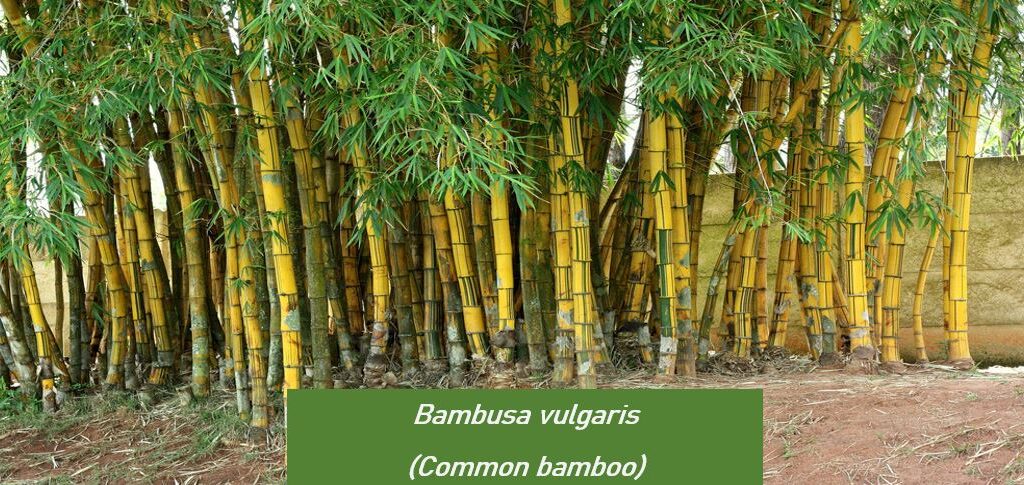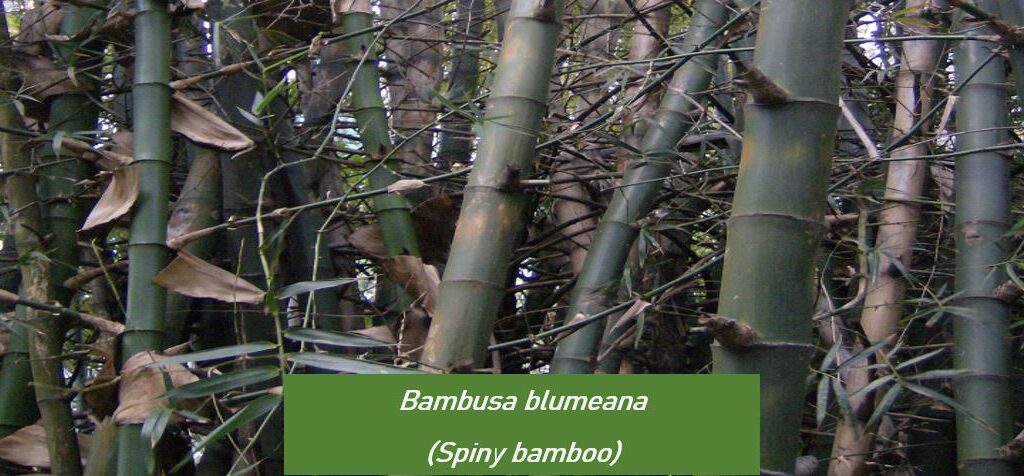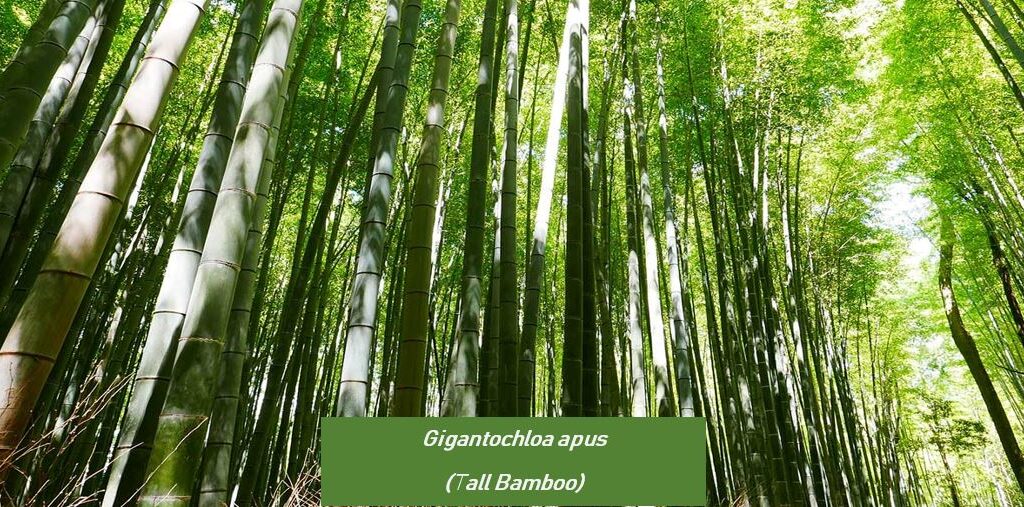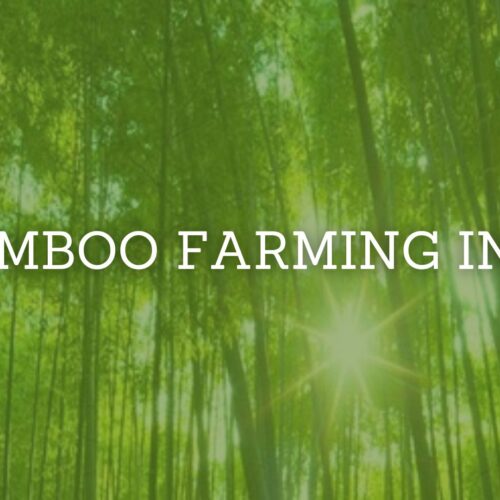What is Bamboo actually?
Bamboo is a tall treelike tropical or semi-tropical fast-growing grasses of the genus Bambusa having hollow wood-walled stems and ring joints and edible young shoots.
It is a type of grass with a stiff woody hollow stem. It is an evergreen perennial that grows year after year and stays green all year round. Hundreds of species grow in different parts of the world, and people have used them for everything from construction to medicine. Most prefer moist, slightly acidic soils and keep them morally clean. It has important cultural and religious implications also.
Bamboo is evergreen and grows well year-round in most environments. They don’t need a lot of water or land to grow happily, but they are also adaptable to growing in water (or hydroponics).
Although its origins are in Asia, most bamboo species can grow anywhere, provided ideal conditions are maintained.
Today we will discuss what are the common types of Bamboo.
Table of Contents
- Bambusa balcooa (Known as Female Bamboo)
- Dendrocalamus strictus (Known as Male Bamboo)
- Bambusa vulgaris (Known as Common Bamboo)
- Video Explaination: Bamboo Farming
- Bambusa blumeana (Known as Spiny Bamboo)
- Bambusa bambos (Known as Giant Thorny Bamboo)
- Bambusa guangxiensis (Known as Chinese Dwarf)
- Bambusa polymorpha (Known as Burmese Bamboo)
- Bambusa textilis (Known as Slender bamboo)
- Gigantochloa apus (Known as Tall bamboo)
- Bambusa ventricosa (Known as Buddha Belly Bamboo)
- Dendrocalamus giganteus (Known as Giant Bamboo)
- Bambusa tulda (Known as Timber bamboo)
- Gigantochloa levis
- Gigantochloa pseudoarundinacea
- Guadua angustifolia
- FAQs: Frequently Asked Questions
Bambusa balcooa (Known as Female Bamboo)

Bambusa balcoa is also known as the lady bamboo. This is a type of bamboo native to northern India, but grows happily in tropical climates similar to its origin.
Like most bamboo plants, female bamboos are evergreen, hardy, and grow quickly.
This kind of bamboo can be used for decorative purposes, but it is also widely used for heavy industry. It is also very common in gardens around the world. Female bamboo can grow up to 80 feet in ideal conditions.
Dendrocalamus strictus (Known as Male Bamboo)

Male bamboo is a type of bamboo native to India, mostly native to the warm and tropical Kolkata. It is one of the most common bamboo species in the region, but is recognized worldwide as an ornamental bamboo species for its decorative flair.
Male bamboo is preferred because of its strength, and is also called iron bamboo. Known for its solid growth, it’s a familiar sight in the industry. It also grows quickly and can reach full length faster than comparable bamboo species. Subtropical climates are best if you want to grow male bamboo.
Bambusa vulgaris (Known as Common Bamboo)

Bambusa vulgaris is the most common bamboo species and is also called common bamboo for this reason. Although native to southern China and Madagascar, it has become one of the most widely cultivated bamboo species in the world.
This is one of the most adaptable species of bamboo. It can be grown anywhere in the garden or pot provided proper conditions are maintained.
Evergreen and gregarious, common bamboo is one of the easiest bamboo species to grow.
If you are new to bamboo, common bamboo is the best way to start. It’s a great place to start as it doesn’t require as much work as other bamboo species.
Common bamboo is sometimes called yellow bamboo because of its appearance and can grow everywhere.
Video Explaination: Bamboo Farming
Bambusa blumeana (Known as Spiny Bamboo)

Spiny bamboo is one of the most widespread bamboo species in the world. This evergreen gregarious bamboo species is native to Indonesia and Malaysia but can grow in tropical or near-tropical conditions.
Spiny bamboo is traditionally used as a building material, but it can also be used for many other industrial uses. The local industry practically relies on regular harvesting for its economy. Tools, fabrics and more can be made from this very strong bamboo seed.
Spiny bamboo is best known as industrial bamboo but is also more commonly grown as an ornamental species.
Bambusa bambos (Known as Giant Thorny Bamboo)

Giant Thorny Bamboo is an evergreen tropical bamboo species native to South Asia.
It is also known as the Indian thorn bamboo, a species of gregarious species that naturally favors tropical and subtropical conditions.
Its rapid growth rate and incredible strength have made giant spiny bamboo common in construction projects and other industries.
Bambusa guangxiensis (Known as Chinese Dwarf)

This type of bamboo is native to China but also grows in most other parts of the world. Unfortunately, it is one of the bamboo species that can be considered invasive in some areas of the United States (including the Southeast).
Chinese dwarf bamboo is often grown as ornamental bamboo and can be grown in pots. It prefers climates like its original habitat (tropical to subtropical).
It’s a lush, voluminous bamboo seed that makes a great houseplant – if you’re in the part of the world where you can grow it.
Bambusa polymorpha (Known as Burmese Bamboo)

Burmese bamboo is a type of bamboo native to Bangladesh, Myanmar, and Thailand. It is also found almost anywhere in the world in near-tropical conditions. This kind of bamboo grows equally happily in gardens and pots.
Burmese bamboo is a gregarious evergreen bamboo that can grow taller (and can result in heavier bamboo species overall). One of the most common uses of Burmese bamboo is in the construction industry, but today it is more popular than ever as a type of bamboo found in gardens.
There are about 100 types of bamboo in Myanmar and it is one of the most popular types.
Bambusa textilis (Known as Slender bamboo)

Slender bamboo is one of the most widespread bamboo species in the world. Although it is native to China, it grows happily in any garden or pot that matches the climate of its origin.
Slender bamboo is sometimes called weaver’s bamboo because it is widely used in the manufacture of fabrics. Slender bamboo is one of the tallest bamboo species, growing up to 50 feet in length.
Consider Slender Bamboo one of the first when it comes to long-lived bamboo seeds that grow happily almost anywhere.
Gigantochloa apus (Known as Tall bamboo)

The name “tall bamboo” might give you a hint!
Tall bamboo is one of the world’s gigantocroa bamboo species and is native to Southeast Asia. It grows happily in tropical or subtropical climates around the world and can be grown in pots or gardens.
Used extensively in the local industry, everything from appliances to building frames is made from tall bamboo. Evergreen, fast-growing, and hardy. It has all the best qualities you can expect from your chosen bamboo variety.
Bambusa ventricosa (Known as Buddha Belly Bamboo)

Bambusa ventricosa is an evergreen bamboo native to southern China. It is one of the most popular ornamental bamboo species that not only grows happily in pots, but can grow to over 50 feet tall.
It is also called Buddha’s belly bamboo because the joints look swollen.
The unique appearance of this bamboo species has made it one of the most popular types of bamboo for homes and gardens.
It grows happily near tropical environments.
Dendrocalamus giganteus (Known as Giant Bamboo)

Giant bamboo is native to China and is commonly known as dragon bamboo in its native ecosystem. Giant bamboo is one of the largest bamboo species left growing, but with a little care, it can also be trimmed to make it perfect for the average home garden.
This versatile bamboo seed can be grown anywhere in the world and is considered easy to grow and will grow all year round.
Dragon bamboo, favored for its toughness, is widely used in industry.
As one of the largest species, this species of bamboo requires a lot of maintenance to control its growth.
![]() Bambusa tulda (Known as Timber bamboo)
Bambusa tulda (Known as Timber bamboo)

Indian timber bamboo, also called Bengal bamboo, is believed to be native to India. Timber bamboo is a popular species of bamboo all over the world that is also found in other parts of the world such as South America.
Timber bamboo is one of the best types of bamboo for industrial use. That’s why it’s called timber bamboo! Because of its strength and fast growth, Timber bamboo is ideal for industrial use, but it is also a great ornamental plant for gardens.
In its natural environment, bamboo is also used to make paper.
Gigantochloa levis

Gigantochloa Levis is an evergreen edible bamboo species native to the Philippines. It is one of the tallest species of bamboo and care should always be taken to trim this plant to size in your home garden or environment.
It prefers subtropical climates but can adapt to the environment with the care of the gardener.
Although it is widely used for industrial purposes, it is also used as an ornamental plant. Its use as a kind of compost is being researched.
![]() Gigantochloa pseudoarundinacea
Gigantochloa pseudoarundinacea

Pseudoarundinacea is one of the world’s largest bamboo species and comes from Indonesia. In Indonesia, this plant is also known as gombang batu, but this variety is also found in many other subtropical regions of the world.
An edible species of bamboo that loves tropical environments and shares most of its similarities (except for size) with common bamboo.
It’s a large bamboo, but it’s great for gardens because you can control its growth with little effort. It can even grow inside.
Guadua angustifolia

Guadua angustifolia is a species of bamboo native to South America, but it is also one of the most popular ornamental and industrial bamboo species in the world.
It is an evergreen, giant woody bamboo that is considered one of the strongest bamboo species you can grow. Being a giant bamboo seed, pruning to length requires control.
This bamboo species is fast-growing, hardy, and known to be great for construction, but is more commonly used for decorative purposes. It is also one of the edible bamboo species and is native to South America. It is one of the few native bamboo species. How big does this kind of bamboo grow?
Angustifolia bamboo can grow over 80 feet in length. This is a rather huge species of giant bamboo.
FAQs: Frequently Asked Questions
What is bamboo and its uses?
Bamboo has many uses, primarily in construction (flooring, roof design, scaffolding), furniture, food, biofuels, fabrics, cloth, paper, pulp, charcoal, ornamental gardening, and environmental properties.
Is bamboo tree or grass?
Scientifically bamboo is not a tree but grass.
Is bamboo a wood?
Bamboo is an excellent renewable resource and environmentally friendly material. It’s actually grass, not the wood used for hardwood floors, and grows much faster than hardwood, making it a very sustainable and eco-friendly product.
Does bamboo produce oxygen?
Perhaps more importantly, bamboo produces over 35% more oxygen than wood, given its carbon footprint, which is considered a threat to global warming and biodiversity.
Is bamboo stronger than wood?
Bamboo is strong as compared to wood. Bamboo fiber is 2-3 times stronger than wood. Maple is one of the densest and strongest hardwoods, while bamboo is stronger and slightly lighter.
Is bamboo stronger than steel?
How is bamboo better than steel? Yes, you might have been shocked but bamboo is stronger than steel in terms of tensile strength. Steel has a tensile strength of 23,000 psi (pounds per square inch). But bamboo outperforms steel by 28,000 psi (pounds per square inch).
Is bamboo stronger than cement?
How strong is bamboo? To know the true strength of bamboo, let’s compare it with traditional building materials. Bamboo has a higher tensile strength than many steel alloys. Bamboo has a higher compressive strength than many concrete mixtures.
Strength of Bamboo
How strong is bamboo? It is a very strong hardwood. Think of it this way. Some of the best hardwoods grow in tropical climates. Plant life in these climates must withstand constant humidity, strong winds, storms, and more. Bamboo is very strong and is used in building construction. It has been used for hundreds of years. You can imagine that the bamboo chairs used in buildings and bridges are of high quality and will last a long time.



